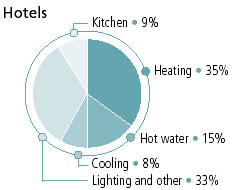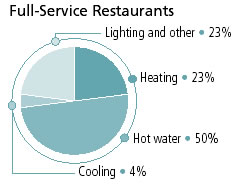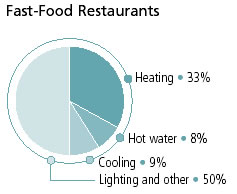ARCHIVED - Step 3: Determine Where You Use Energy
Information Archived on the Web
Information identified as archived on the Web is for reference, research or recordkeeping purposes. It has not been altered or updated after the date of archiving. Web pages that are archived on the Web are not subject to the Government of Canada Web Standards. As per the Communications Policy of the Government of Canada, you can request alternate formats. Please "contact us" to request a format other than those available.
Before you can reduce consumption, you must determine how you are currently using energy. With this knowledge, you can identify areas in which you have the greatest opportunity to save.
If you run a hotel, your major energy expenditures will include lighting for guest rooms and common areas, HVAC (heating, ventilating and air conditioning) and motors in equipment such as elevators. Energy use in restaurants, on the other hand, is concentrated in kitchen areas, although lighting consumption is also a major factor in fast-food restaurants. This guide presents more details on the sources of energy consumption and the retrofits that can decrease your consumption in Step 4: Invest in Energy Efficiency Retrofits.
Without conducting an energy audit, it is difficult to calculate exact energy-use statistics, but the following charts can help since they show typical energy-use breakdowns.*



You Cannot Manage What You Do Not Measure
An audit by an energy professional can help you determine amounts and types of energy consumed in your facilities, as well as feasible retrofit options. Audits provide the data needed to prepare an Energy Management Plan for your organization (see the box on page 7). Consult with an energy professional to determine the audit type that best suits your facility and budget.
-
Preliminary audits are basic inspections in which utility and facility data are gathered and analysed. These audits establish baselines and define a building's average energy consumption.
-
Walk-through audits involve a review of a facility's energy-use profiles, as well as overall assessments of energy-consuming systems.
-
Energy audits/feasibility studies are the most complex audits providing detailed analyses of facility energy-use profiles, as well as exhaustive descriptions of building systems and their operations and levels of performance. These audits can help you fully understand your facility's energy consumption, including the potential to deliver energy management savings.
Detailed descriptions can be found in the publication Federal Buildings Initiative Audit Standards Guidelines located at oee.nrcan.gc.ca/publications.
Page details
- Date modified: